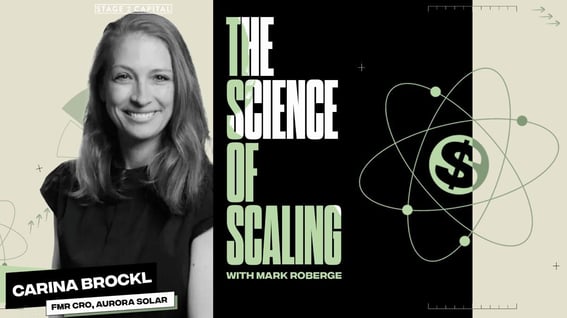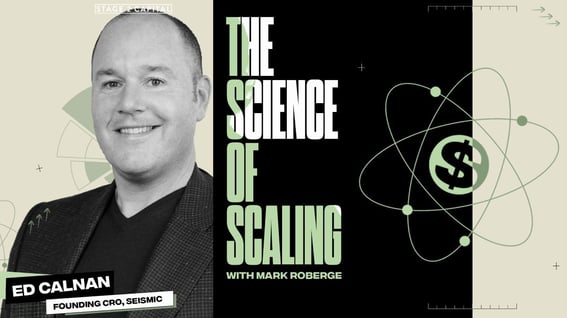From Blitzscaling to Rule of 40: Lessons in Profitable Growth from Box’s CRO, Mark Wayland
How SaaS leaders must adapt their go-to-market strategies, hiring profiles, and growth mindset to thrive in a measured, profitable future.

How SaaS leaders must adapt their go-to-market strategies, hiring profiles, and growth mindset to thrive in a measured, profitable future.

There’s a long-standing lore in the SaaS and tech world: the unicorn dream of triple-triple-double-double, “blitzscaling,” and growing at all costs. And yet, as Mark Wayland, CRO at Box and Stage 2 Capital LP, shares in the “Science of Scaling” podcast with host Mark Roberge, this path is rarely straightforward — and often, it’s not even advisable. The market tides are shifting toward sustainability and profitability, driven by economic forces and changing investor expectations.
Let’s unpack what it means to move from a “grow at all costs” mentality to a discipline rooted in the Rule of 40, and how this impacts hiring, execution, and go-to-market strategy.
For years, the playbook in Silicon Valley has preached: raise big, spend fast, capture category leadership, and hire ahead of demand. This approach, known as blitzscaling, is built on the idea that first-mover advantage is everything — that capital lets you dominate engineering and sales hiring, win TechCrunch headlines, and define a category before the competition can catch up.
But as Roberge summarizes, “10% of the time, blitzscaling works out. 90% of the time, it doesn’t.” The real risk isn’t just missed unicorn status; it’s clinging to high-burn tactics long after the data suggests you won’t make it. The result? Ineffective go-to-market systems, burned capital, and missed opportunities for more sustainable wins.
Enter the Rule of 40: a metric where a SaaS company’s growth rate plus profit margin should reach at least 40%. This approach, rooted in private equity rigor and increasingly adopted by public SaaS companies, asks leaders to be accountable not just for growth, but for how efficiently it’s achieved.
Wayland describes the transformation at Box triggered by an activist investor: “You need to grow faster and you need to cut costs, and if you don't, you're not going to like the way it goes.” The reality? Making money, even at the cost of measured growth, became a simple necessity. The result was both financial discipline and, surprisingly, organizational clarity: fewer projects, more focused meetings, and executives actually able to focus where it mattered most.
When the oxygen is flowing — markets are hot, capital is cheap — it’s easy for even mediocre salespeople to hit quota. But in a Rule of 40 world, Wayland insists, the winners are different. His top two traits for sales hires? Business acumen and grit.
"Business acumen" means the ability to diagnose root-cause business problems and sell use-case solutions, not just feature dump. "Grit" is tested through adversity — Wayland wants to know about painful failures as much as wins. In lean times, those who coast or expect things to come easy will simply not endure. This elevates the quality of the sales force and improves long-term outcomes.
When budgets tighten and every dollar counts, marketing and sales can no longer afford to work in siloes or point fingers. At Box, Wayland and the CMO jointly review pipeline metrics and treat demand generation as a shared, company-wide responsibility.
As Wayland puts it: “Every dollar that marketing creates costs money... but every dollar of pipeline that an AE creates, in a sense, is free because those heads are already built into your financial model.” This shift means sales is as responsible for pipeline as marketing, and results in nimble, accountable revenue teams that iterate together, not apart.
Rule of 40 doesn't mean cutting all innovation or experimentation; it means being judicious with scale and spend. New products, AI offerings, and process improvements are still critical — but investments are staged and measured. “You’re stepping into the investments as you show results,” Wayland notes, “rather than writing an open check and checking in later.”
Box’s story demonstrates that while blitzscaling might win headlines, Rule of 40 wins sustainable success. The path to enduring value runs through discipline: smarter hiring, more accountable go-to-market systems, and a willingness to pivot strategy as circumstances demand. For founders and sales leaders, this isn’t a retreat — it’s evolution. As Wayland says, “Profitable growth is a good thing.”
Listen to this episode of “The Science of Scaling” for more tactical insight, and start thinking about how your growth playbook needs to evolve — before the market forces you to.
~~~~~
Note: The insights shared in this podcast were initially distilled through advanced AI summarization technologies, with subsequent refinements made by the writer and our editorial team to ensure clarity and engagement.
Every week during a season, host Mark Roberge—co-founder and Managing Director at Stage 2 Capital and a senior lecturer at the Harvard Business School—interviews some of the tech industry's most successful and renowned leaders and managers in the areas of sales growth and Go-to-Market strategy. This is a HubSpot for Startups original podcast, and part of HubSpot's Podcast network. It's available on Apple, Spotify, and anywhere you get podcasts.

From handling explosive growth to navigating turbulent markets and layoffs, get insights on navigating startup challenges in this interview with Carina Brockl, former CRO at Aurora Solar.

Find out how Seismic used a “whale hunting” approach to scale from $0 to millions in ARR in this interview with co-founder and former CRO Ed Calnan.

In this episode, Perplexity.ai’s Chief Business Officer Dmitry Shevelenko shares an innovative growth playbook that is helping the startup go head-to-head with tech giants like Google.
